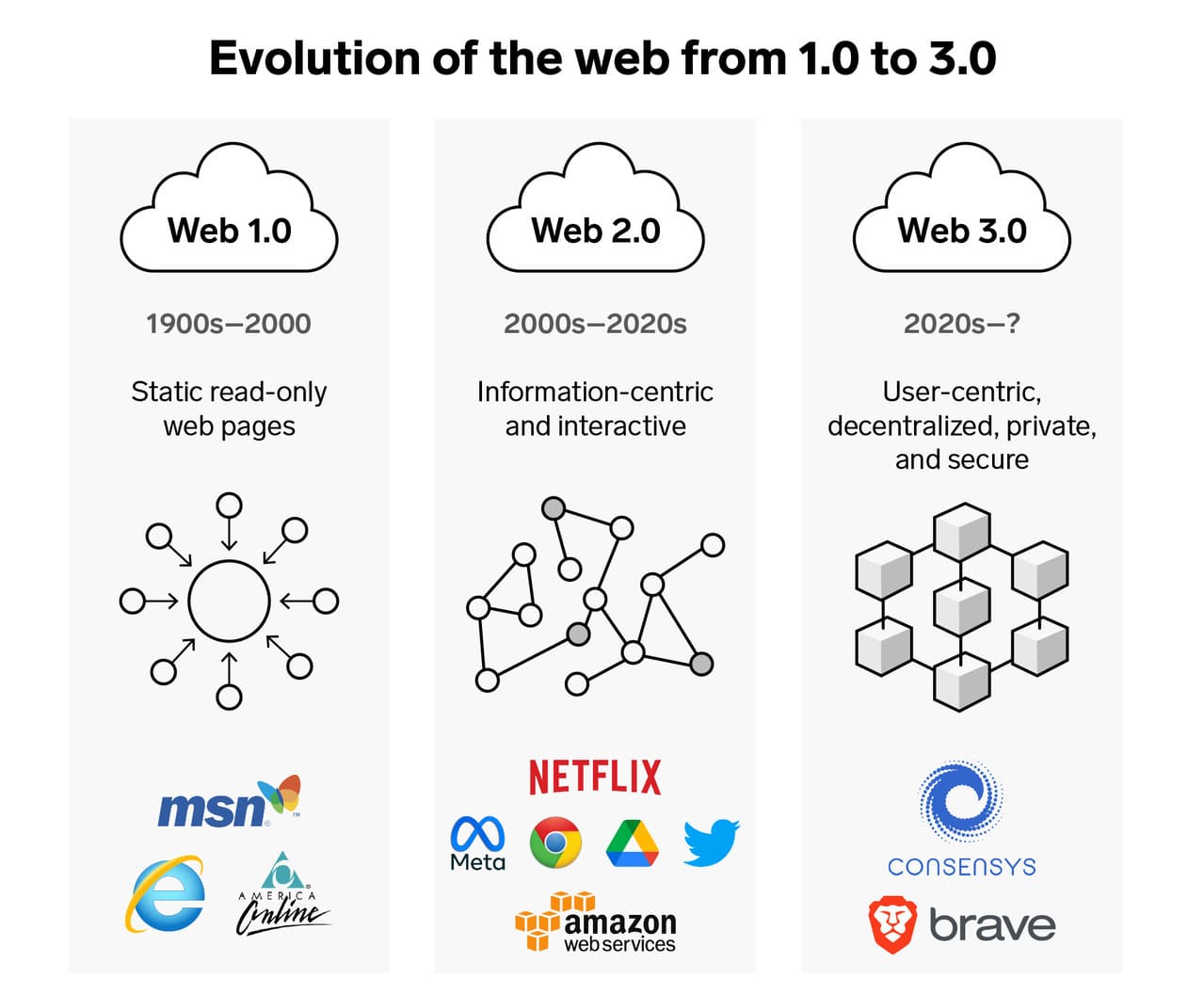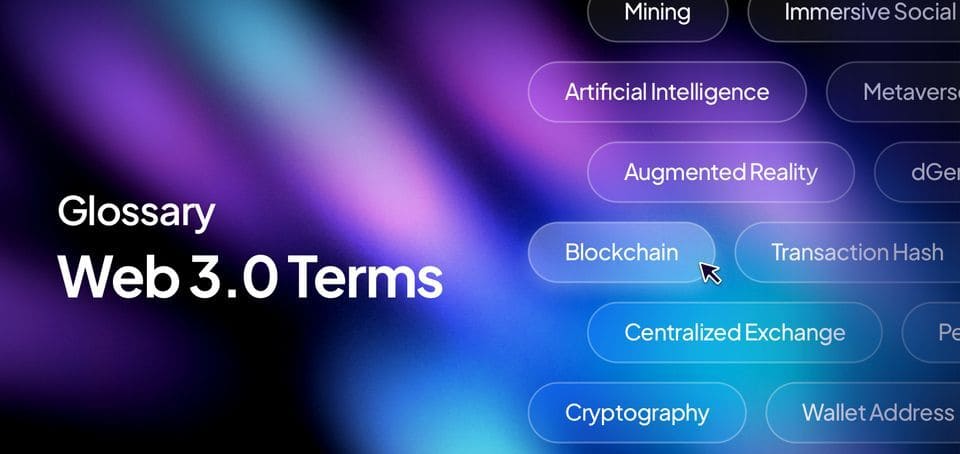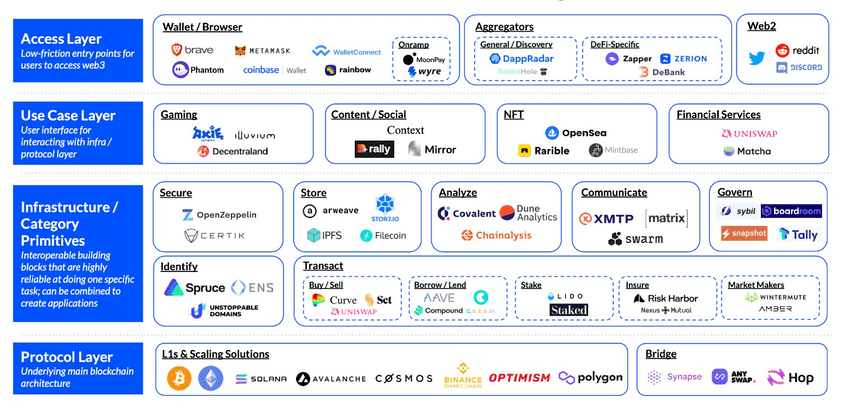Table Of Contents 👉
- A Simple Introduction To Web1, Web2 And Web3
- What is Web3? (According To Experts)
- Web2 vs Web3
- Web3 Examples And Applications
- Various Terms and Concepts In Web3
- The Web3 Stack
- Where Can I Hire Web3 Developers?
- Is Web3.0 Centralized?
- Web3.0 Limitations
- FAQs On Web3.0
- What Is Web3.0?
- What Are The Examples Of Web3?
- Why Should We Care About Web3?
- How To Access Web3?
- How Does Identity Work In Web3?
- Is Web3 Crypto?
- How To Invest In Web3?
- What Is The Salary Of A Web3 Developer?
- What Are The Best Free Resources To Get Into Web3.0?
- What Is The Best Way To Learn Web3.0?
- What Are The Best Web3.0 Projects?
A Simple Introduction To Web1, Web2 And Web3
Small Intro To Web1 Web2 And Web3: With the advent of the world wide web and the period of Web 1.0 (or read-only Web), from 1989 to 2005, Users were primarily consumers.
Static texts by businesses of multiple industries used this platform to show news, articles, products, and anything bounded by the walls of text. No user could edit or create content, and the customer base was reasonably low.
In 2014, The co-creator of the Ethereum Blockchain, Gavin Wood, coined the word ‘Web 3.0’. Internet on the Blockchain in simple terms. Instead of centralized web servers, multiple users worldwide would track and compile data in blocks to keep the internet running 24/7, 365 Days.

Data could and would not be kept by one organization, it would be stored in the Blockchain. Users and moderators are given cryptocurrencies to keep the system running.
Cryptocurrencies, NFTs, DeFi applications, Blockchain Video Games, and everything available on Web 2.0 would be in Web 3.0, without any data tracking. This decentralization is the most promising feature of Web 3.0.
Furthermore, DAOs or decentralized autonomous organizations will aid in maintaining the system that would comprise all company shareholders. The decisions will not be made by the CEO but by all executives, i.e. all the shareholders.
What is Web3? (According To Experts)
Web 3.0 is a decentralized network powered by AI & ML (Artificial Intelligence and Machine Learning) and backed by the Blockchain.
This version of the Web enables users to control who uses data of the people, who they let track, and who they choose to trade data with.
Professor Jason Potts and Ellie Rennie from RMIT University, 2019, defined Web3 as a revolutionary digital infrastructure enabling users to share data without using third-party enterprises.
In 2022, professor John M. Garon from NSU Florida recently gave an opinion that advocated for DAOs. He said that Web3 is a massive shift in the internet commerce field.
Web2 vs Web3
Web 2.0 (or read-write Web) revolutionized the world with its ability to provide users with a platform to create and see the content. It gave a new industry for people to earn money from.
Businesses display advertisements on social media, newspapers, and marketplaces, which give creators of both the content and the website income.
As the old saying goes, “There’s no free lunch in this world”. Companies trade your personal information in exchange for their amenities.
These companies are the rule-makers and rulebreakers of this version of the internet. They have a say in what gets on or off the Web.
Twitter removes anything which violates its guidelines, and so do Youtube and Twitch. Web2 is also at risk of internet blackouts. Many people rely on the internet for their livelihoods, Meta and Google have both experienced numerous blackouts in the history of web2.
Web 3.0, on the other hand, runs on the Ethereum network. Web3 includes Dapps or “decentralized apps” which work on the Ethereum blockchain, using ether as currency.
No one person or organization can block or deny you access to any website or domain. Web3 doesn’t require permission. Web 3 is powered by millions of computers acting as a backend.
There is no risk of network loss, which allows users a carefree environment. Although Web3 has numerous benefits, it isn’t easy to use and has a complex UX, making new users avoid it.
Popular Stories In Web3:
Web3 Examples And Applications

Web3 has many examples of Dapps, including Sapien, Everledger, LBRY, Storj, Ethlance, Design, and Brave Browser. A web browser, MetaMask, connects your device to the Ethereum blockchain. It allows its users to trade, swap tokens, and share data.
Brave Browser accepts and rewards its users’ tokens of the ERC-20 and BAT tokens.
3Box is an online cloud storage application on the Ethereum network.
MyCryptoWallet is an online wallet manager that lets its users trade, send, and buy crypto from all of their wallets.
Civic is an online identity and data management Dapp, accepting its cryptocurrency, CVC.
Rarible is an online community-owned NFT marketplace. Bilski allows its users to create, sell, and display their NFTs.
OpenSea is a popular NFT marketplace with peer-to-peer crypto-collectable and rare NFT trading.
Web3 has numerous applications, including but not limited to: Web Browsers, Cloud storage, Wallet Management, Art Marketplaces, Music Streaming platforms, Decentralized Finance applications(DeFi), Portfolio Management, DAOs(Decentralized Autonomous Organizations), Prediction Markets, Work-Related Applications, Collectible Management, Video Games, Video Streaming Platforms, Virtual Real Estate, Social Media Networks, Messaging and Data Sharing Platforms, Remote Job Platforms, and the most used, Decentralized Exchanges.
Various Terms and Concepts In Web3

Airdrop – An airdrop is the transfer of tokens, coins or NFTs distributed to aQ web3 wallet address at no cost to promote a product or as a reward for taking part in an event or buying a digital asset.
Altcoin – A cryptocurrency other than Bitcoin, has a small market capitalization.
Bitcoin – Bitcoin is an electronic currency created to function as a payment not controlled by any individual, group, or entity. This eliminates the need for third parties to participate in real-world transactions.
Block – Record of transactions done on the Blockchain. Every block has information about the previous one, hence forming a chain.
Blockchain – A blockchain is a decentralized and distributed ledger made up of blocks. Blocks are used to track transactions across multiple computers so that modifications to each block cannot affect subsequent blocks.
Bridge – A bridge in the form of a protocol that allows the transfer of data, tokens, and other information from one Blockchain to the other.
Burn – Removing a cryptocurrency from a circulating supply by sending tokens to an inaccessible wallet address.
Cold Wallet – A device in the offline sphere for storing cryptocurrency.
Cryptocurrency – Digital asset used as a means of exchange.
DAOs – An organization based on open-source and governed by its users.
DApps – Applications are living on the Blockchain. They reward their users for maintaining them.
DeFi – Trustless, borderless, and open-source financial institutions built on the Blockchain without the use of banks.
Ethereum – It is a Blockchain used extensively for Dapps. It is also Turing complete.
Fiat – A currency used in the real world. Like the US Dollar. Which can be controlled by Authorities.
Fork – A change in the Blockchain’s protocol.
FUD – Fear, Uncertainty, Doubt.
Fungible – Interchangeable.
Hashing – Creating data that is not recognizable after taking input.
Hash Rate – Hash rate is a measure of the computing power on a cryptocurrency network
HODL – Hold on for dear life. Meant to be taken as holding a cryptocurrency and not selling it.
ICO – Initial Coin Offering.
Metaverse -A virtual reality world
Mining – Process verifying transactions, organizing, and adding them to the Blockchain.
NFT – Non-fungible token.
Node – A device that stays online on the Blockchain
Protocol – It is the layer made up of software for a program.
Rug Pull – The creators attract investors with crypto schemes, take their funds and run away. Simply, we can say it a scam.
Stablecoin – It is a coin which is backed by an actual currency. It can also be pegged to gold, silver, diamonds, or even cryptocurrency.
Token – A denomination of a currency on the Blockchain
Wallet – Used to store crypto on the Blockchain.
Related Web3 And Other Stories:
The Web3 Stack

Where Can I Hire Web3 Developers?
For those looking to hire skilled and experienced Web3 developers, a good starting point is Webisoft.com. They have a robust team of developers that specialize in Web3, offering comprehensive services in this emerging sector of internet technology. Webisoft not only provides access to professionals who have a deep understanding of the decentralized web, blockchain technology, and smart contracts, but they also understand the dynamics of project management to deliver effective solutions on time and within budget. The firm has an excellent reputation for meeting the unique needs of their clients, making it an ideal choice for those in search of top-tier Web3 developers.
Is Web3.0 Centralized?
This is a very complex question. On the one hand, we have venture capitalists who own a majority stake in crypto projects. At the same time, on the other, the entire ecosystem of Web3 is based on decentralization.
In most cases, Web3 is decentralized. There is less control in VCs as the network is peer-to-peer based. So most of the nodes must take a decision, and the nodes are anonymous, unlike the centralized Web, where companies take every data about you.
Web3.0 Limitations
There are some limitations of Web3 which don’t enable it to become mainstream. Web3 is difficult for people in third-world countries to access, as the relative cost of transactions is prohibitive to many.
Higher levels of adoption are needed to make Web3 accessible to everyone. The technical barrier to accessing Web3 is high right now.
Users need to have knowledge of security concerns and must know how to use basic UI. There should be a drive to educate, like in the 90s, when terms became famous to the general public, including browsing, Browser, and the Internet. That’s all. One more thing i.e. this guide will be updates time to time, so stay tuned with us.
FAQs On Web3.0
What Is Web3.0?
Web3 is the updated version of the internet. It uses ideas such as decentralization, Blockchain, and tokenization. In layman’s terms, Web3.0 is a web with more transparency, no data tracking/selling, more privacy, and no single-person control.
What Are The Examples Of Web3?
Some of the best examples of Web3 are Sapien, Everledger, LBRY, Storj, Ethlance, Ysign, and Brave Browser. These are few projects build on Web3.0.
Why Should We Care About Web3?
Web3 gives the following advantages to its users:- Ownership, Censorship Resistance, Identity, Native Payment System, No permissions required, No denial of access, and Turing-complete blockchain(anyone can program anything). That’s why people cares about Web3.0
How To Access Web3?
These are the steps to access the Web3 – Get a wallet, Find a community, Explore Web3 applications, Join a DAO, and Build on Web3.0
How Does Identity Work In Web3?
In Web3, Identity is tied to the wallet address of the person interacting with the application. If the user decides to utilize the same wallet on different apps, their information is also transferrable seamlessly across different apps, which helps the user build their profile in time.
Is Web3 Crypto?
No. Web3 is not Crypto. It is the third generation of the internet.
How To Invest In Web3?
One of the most effective way to invest in Web3 is by building an investment portfolio that includes appropriate assets. You can invest in Web3 in the following ways :- Buying And Selling Virtual Real Estate, Playing Video Games, Investing in Crypto and NFTs.
What Is The Salary Of A Web3 Developer?
The average salary of a Web3 developer is $80,000.
What Are The Best Free Resources To Get Into Web3.0?
Top resources to learn about Web3.0 are
1. Blockchain Demo – Learn Blockchain Visually
2. Eth Build – Learn Ethereum Visually
3. NFTSchool – Learn And Share About NFTs
4. Solidity by Example
5. Odyssey – Web3 For Beginners
6. Crypto Zombies – Learn Web3 By Building Your Own Game
7. Buildspace – Web3 Projects
Check out all 30+ free web3 resources.
What Is The Best Way To Learn Web3.0?
You can start your Web3 journey by Joining Web3 University, enrolling in online courses on Web3, Starting building apps on Web3, reading Tutorials and Articles on Web3, and Giving Web3 practice tests on Udemy. Go through the list of all the best courses on web3.
What Are The Best Web3.0 Projects?
Some of the best Web3 Projects are How To Build Your First Blockchain App Using Ethereum, Smart Contracts and Solidity, How To Write & Deploy An NFT, How To Create A Platform Like OpenSea, Build and Deploy a Modern Web 3.0 Blockchain App, Build A Decentralized Airbnb On Polygon, etc. Go Through all 70+ Best Web3 Projects.
